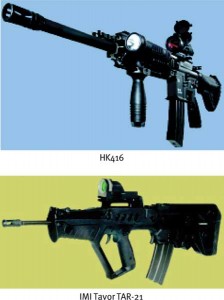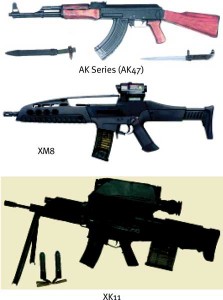Consider the 5.56 family of weapons that the Army is currently equipped. The Army was virtually bulldozed into accepting these weapons. It was told that indigenous R&D must be encouraged. Promises were made that in the production models the user will get a much improved and more reliable version and that a superior Mark 2 will follow. The DRDO also hinted that high volume orders from many foreign customers would be placed soon after the Indian Army accepted the induction and placed orders for delivery. The Army had no choice but to accept though none of the commitments materialized. It has lived with these weapons for more than a decade and paid an incalculable price. A good and reliable personal weapon we know does wonders to a soldier’s confidence and morale. But we have failed in giving him such a weapon. Shouldn’t there be review and people held accountable?
Conceptually the start point of capability–building and modernization has to be the individual soldier. So we must begin by giving him the best we can. Essentially what the soldier needs is a good and reliable personal weapon, comfortable clothing with stealth and concealment features designed to ergonomically accommodate everything he has to carry, the best protection (body armor) that portable weight permits, stabilized helmet mounted computer screens, sensors and night vision devices for observation and using his weapons, effective communications and position locating/ situational awareness systems. In addition he requires a host of sundry items like eye protection goggles, contemporary light bag pack equipment etc. The approach should be to look at the tactical vest and the helmet (protective gear) as a platform on which the future soldier systems are embedded so that weight reduction and mobility improvements issues are optimally addressed.
 The resolve to modernize the infantry soldier has been there for long, but the process has been painfully slow. Ways have to be found to accelerate the process and do it comprehensively. We must therefore begin as of yesterday.When considering assault rifles we have quite a few options available; each having its unique features. Let us briefly look at the 21st century trends in assault rifles. Essentially they are refinements to the systems developed in the previous decades. Some exciting options that could be considered are:-
The resolve to modernize the infantry soldier has been there for long, but the process has been painfully slow. Ways have to be found to accelerate the process and do it comprehensively. We must therefore begin as of yesterday.When considering assault rifles we have quite a few options available; each having its unique features. Let us briefly look at the 21st century trends in assault rifles. Essentially they are refinements to the systems developed in the previous decades. Some exciting options that could be considered are:-
- Heckler & Koch HK 416 firing the 5.56x 45 or the HK 417 firing the 7.62×51 NATO rounds. Both these weapons have updated features with Picatinny rails, a drop free magazine release, and some other smart features.
- Israel’s IMI Tavor TAR-21. It has a compact bull pup design and uses the NATO 5.56x 45 cartridges. It can easily be set up for right or left handed shooters and has several modular variants that come with a standard reflex sight.
- XM 8 from the US. This has quite a few modular variants with inbuilt electronics such as a laser sight, round counter and integral infra red and visible sights.

- South Korea’s XK11. This is an interesting new rifle that has a ballistic computer, a laser range finder and a digital scope that provides the soldier with combat data and enables night firing through thermal imaging sights. The product is still at a prototype stage but has considerable promise.
- The AK Series. The Kalashnikovs family of assault rifles is much too well known.
An important trend in small arms in the 21st century is that sophisticated electronics is now being built into the design of these weapons. Whereas I believe we are currently looking at the weapons and the allied electronics as two separate systems to be procured independent of each other and then integrated. There could be some justification for the approach we have now adopted. A few years ago we had considered integration of night sights in our tender for assault rifles. At that time there weren’t many who were offering such embedded systems. To my mind the idea was right though the timing was wrong. But now, with most weapon manufacturers developing weapons with built in electronics, I am not too sure whether we should be jettisoning a sound concept.
“¦blinded by the labels of “˜support and “˜supported, the Army has not yet grasped the full import of the modern artillery on tomorrows battlefield.
Given the current employment of the Army and looking at the two vital needs of the infantry soldier i.e. his personal weapon and his body armor, it is difficult to decide which merits greater priority. What is but evident that on both counts the establishment has been found wanting.
Today we have all of the Rashtriya Rifles and a significant proportion of the Army deployed in combating militancy, terrorism and insurgencies. Of these how many of their personnel, are equipped with suitable body armor? And what are the constraints to procuring body armor? On both counts we will get answers that are far from convincing, particularly when today we have a host of companies in India manufacturing body armor and combat helmets. With a dynamic and inclusive approach we can harness the capabilities of these companies to give us quality protection suits and helmets at competitive prices. As a matter of fact with some support in terms of investment in R&D and inducements of assured orders, our companies can well become global leaders in protective solutions.
Assessments suggest that in the development of ‘small arms protective inserts’ (SAPI), technology today is at only the 40 percent level. Both in the case of X SAPI – silicon carbide and ceramic and E SAPI, and high molecular weight polyethylene (HMW- PE) and aramid fibers, there are possibilities that by improving the quality of resins and making the weave more unidirectional, weight to protection ratios can be substantially improved.
The infantry also needs to acquire better surveillance and target acquisition capabilities as well as more potent fire power at the section level and above. A mission, terrain and adversary based analysis may suggest the induction of special weapons and surveillance systems on a regional basis. It can be assumed that such an exercise would have been undertaken.





The Indian army needs a total Re-appraisal in many spheres esp. in the Selection board policies & promotions to see that that the right type of people make it to the level of Commanding officers & further up to the army high command..One more aspect needs to be looked at urgently.I remember my classmates in army public school giving first choice to Arms[Armoured & Infantry ] when they joined NDA & IMA & the toppers got Armoured & infantry.Nowdays, the toppers in NDA are choosing the Services like the Army Supply corps, Ordnance etc where they can make money-The result is poor type of COs of battalions & regiments.